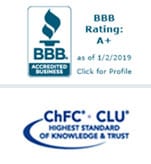

1. Missed Deadlines
What it is
If you don’t take your RMD or take it after the December 31st deadline, you will be subject to a 50% penalty. That means half of your withdrawal goes directly to the IRS.
What you can do about it
You have the option to appeal the penalty for a missed deadline. This isn’t a guarantee that the IRS will let you go with only a slap on the wrist, but it is worth a try, especially if you missed the withdrawal because of extenuating circumstances such as a serious illness or natural disaster. The first step of making your appeal is to withdraw your RMD in full. Then, notify the IRS using Form 5329. Along with your form, prepare a brief letter explaining why you missed the deadline. Don’t forget to mention that you have already requested your RMD from your account custodian. If possible, have the form and letter reviewed by a tax professional you can trust. Once you’ve built the strongest case possible, send both the form and your letter to the IRS.
2. Withdrawing from the Wrong Account
What it is
If you withdraw your RMD from an account with market exposure while the stock market is down, you will have less money in the account to help you recover from any losses.
What you can do about it
The best offense, they say, is a good defense. One of the best ways to defend yourself from market turmoil is to have at least one retirement account with principal guarantee. Principal-guaranteed accounts cannot lose money (i.e., your original investment is “guaranteed” safe). Popular options include savings accounts, CDs, and certain types of annuities. Then, in years with poor stock performance, withdraw your RMD from your principal-guaranteed account so that your non-guaranteed account has the best chance to recover.
3. Underpaying
What it is
Underpaying occurs when the total yearly withdrawals from your qualified retirement accounts are less than your RMD amount. Underpay on your RMD and the IRS will lay claim to 50% of the difference.
What you can do about it
If you are worried about underpaying on your RMD, there are several steps you can take to make sure you pay the correct amount. You can outsource the math to a financial advisor, automate your payments, or opt for an annual withdrawal strategy that only requires one withdrawal per year. If you have trouble keeping track of your retirement accounts, you might want to try consolidating, or, if it makes sense, converting to a Roth IRA. If you have underpaid for a previous year, you can appeal to the IRS for a penalty waiver. Withdraw the difference, fill out Form 5329, write your explanation letter, and work with a tax professional to notify the IRS.
4. Roth Conversion Errors
What it is
If you converted to a Roth account without first withdrawing your RMD, the money that should have been distributed is treated as an excess contribution and receives a 6% penalty each year it remains in the Roth account. Remember: your RMD is not included in the taxes you pay when the conversion takes place.
What you can do about it
Take your RMD at least two months before your Roth conversion date so that the funds have adequate time to leave your account. If the conversion has already occurred, withdraw your RMD amount immediately.
Want more RMD tips? Sign up to receive our free ebook, The Headache-Free Guide to RMDs. Available in 2020.


Sara McKinney
saractag@gmail.com
As Cowen Tax Advisory Group’s Digital Content Marketing Specialist, Sara provides in-house copywriting and manages the company’s electronic records system, email marketing, and blog.




